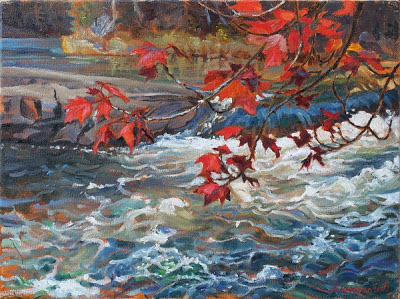Indian Creek Culvert (oil on canvas 5 x 7 in.) Sold
13 September finds us on Indian Creek at Forsythe Road north of Roebuck, Ontario - where I painted an upstream view from the road on my birthday, on 26 December 2005. Today we're on the downstream side. Fred has waded out of sight while I crouch on a rock, admiring the far creek bank's bright keyhole reflection through one of the five large culverts. Wind moves in nearby treetops with an all encompassing roar, and then in the tree tops farther up the creek with a sound like distant surf, and then behind me in a slowly rising and falling "hushshsh" while soft dark cumulus clouds scud quickly past the higher white ones in the chalky cobalt sky. A large Monarch Butterfly passes silently a few feet above my head. It feels like the last day of summer on Indian Creek.
A Rana clamitans (Green Frog), green headed with a slim brown body hops from the creekside grasses into the shelter of the brown leaved indigo berried Dogwood bushes. The water is low and still, its surface broken by shoals of mossy stones and patterned brightly with fallen Ash, Elm, and Maple leaves. Beside me a Swamp Milkweed's curly-silked seeds are being coaxed by the wind from their split brown pods, and at the tip of a neighbouring branch a cluster of still green pods is raised like five candles among long green leaves. The tall banks of Spotted Joe Pye Weed are still green leaved but their once purple heads are now brown with seeds.
Blue Jays ring their rain calls and hidden Redwinged Blackbirds "chuck". No more territorial calls that used to enliven the marshes. It's soon time to head south. A faint honking of a flock of Canada Goose confirms the sentiment. The sky in the north is now dark with pregnant cloud and the treetops are swaying ahead of the storm that will bring our promised cold front.We're here looking for signs that new species of Unionids had been carried into the creek by the fish ladder the South Nation Conservation had installed at a small dam downstream several years ago. Water is low with no visible flow, but with the midstream bottom not exposed. A moderate crop of fruit on Common Buckthorn which is the dominant roadside shrub. The main emergent is tall Bur-reed, especially along the N side of the pool below the culverts, Lemna minor is the only Duckweed; Moss and Elodea are the bottom vegetation above the culverts.
Fred returns at 19:20, reporting having found three Orconectes virilis crayfish and the shells of Pyganodon grandis mussels but no living mussels or snails. Cardinal Flower is still in bloom and he found 4 Monarch Butterfly caterpillars.




We're here looking for signs that new species of Unionids, especially Lampsilis have been carried into the creek as larval glochidia on their host fish using by the fish ladder the South Nation Conservation installed at a small dam a few 100m downstream of here in 2006. Water is low with no visible flow, but with the midstream bottom not exposed. The only species of mussel found was Pyganodon grandis (Common Floater), old shells & fragments, 1 pair, 4 valves, largest 115.5 mm. No sign that there's been any recent mortality, either by predation (except perhaps for one fresh valve on a rock) or drought. Blind groping and scanning the bottom where it was visible, didn't detect any living Unionids. There's lots of Procyon lotor (Raccoon) tracks in the mud along the shore, so potential predators are present; either the populations haven't recovered from the massive mortality found here in September 2001 after the droughts of that year and 1999, the recovery is currently made up of small juveniles, or the living ones are not conspicuous by being well tucked down into the bottom sediment.
ReplyDelete7 Sept 2012: This year, with a real drought, the culverts are empty, and there's no water in the creek until two puddles 300m upstream, and dry above that. The bed of the creek is littered with what I was looking for last year: what I take to be Raccoon-eaten mussel shells, of the same three species seen in 2001 - Pyganodon grandis, Elliptio complanata, and Lasmigona compressa. Either fish haven't been passing the fishway in big numbers, or in the spring when they do pass they aren't carrying larval mussels. It looks like the fishway may be needed to repopulate the stream with fish as well as mussels - there's less water today than there was in 2001.
ReplyDelete